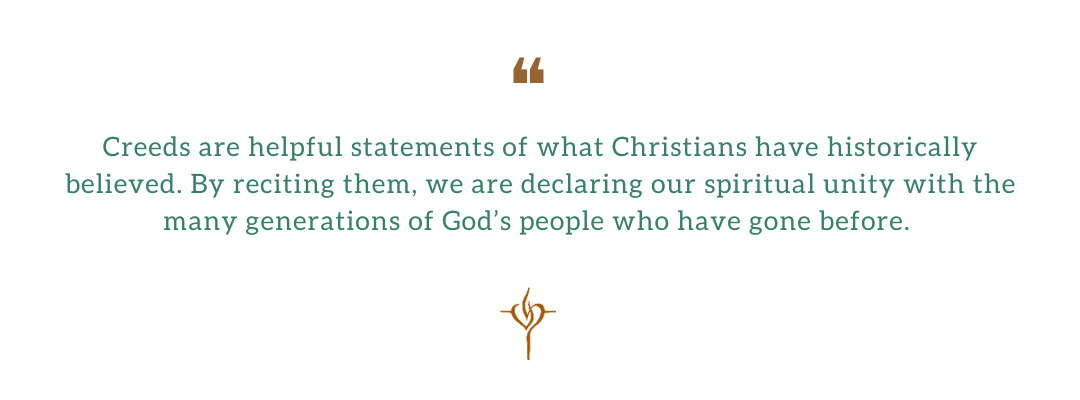Together in the Truth (Part 1)
Pastor Eugene explains what is a statement of faith and its place in our life together as a church.
At our corporate worship services on the first Sunday of every month, we recite a historic Christian creed or an excerpt from our statement of faith. In doing so, we emulate what God’s people have been doing since the beginning of biblical history.
Speaking to all Israel as it assembled beyond the Jordan in the wilderness, Moses declared: “Hear, O Israel: The LORD our God, the LORD is one. You shall love the LORD your God with all your heart and with all your soul and with all your might. (Deut 6:4-5)" He was calling God’s people to know and live according to God’s truth. Subsequent generations of Israelites would later recite these verses as a way of professing their belief in the one true God.
The New Testament also contains concise summaries of truth that helped early Christians to understand and affirm the biblical gospel. Here are two examples:
1 Corinthians 15:3-5 – “For I delivered to you as of first importance what I also received: that Christ died for our sins in accordance with the Scriptures, that he was buried, that he was raised on the third day in accordance with the Scriptures, and that he appeared to Cephas, then to the twelve.”
Philippians 2:6-11 – “Though he was in the form of God, did not count equality with God a thing to be grasped, but emptied himself, by taking the form of a servant, being born in the likeness of men. And being found in human form, he humbled himself by becoming obedient to the point of death, even death on a cross. Therefore God has highly exalted him and bestowed on him the name that is above every name, so that at the name of Jesus every knee should bow, in heaven and on earth and under the earth, and every tongue confess that Jesus Christ is Lord, to the glory of God the Father.”
The Corinthians passage is a succinct statement of the heart of the biblical gospel—the death and resurrection of Christ. The passage from Philippians is a poetic summary of Jesus’ humility and glory, as manifest through his incarnation, death, and exaltation as God’s risen King.
The early church continued to summarise biblical truth in brief statements known as creeds, including the Apostles’ Creed, the Nicene Creed, the Athanasian Creed, and the Chalcedonian Definition. The word “creed” comes from the Latin word “credo”, which means “I believe”. Many creeds, such as the Apostles’ Creed and Nicene Creed, begin with the word “credo”.
The Apostles’ Creed affirms a belief in the Triune God—Father, Son, and Spirit, the universal church, and the bodily resurrection unto eternal life. The Nicene Creed echoes the affirmations of the Apostles’ Creed, but it was written to address false teachings that minimised or even denied the divinity of Christ. The Athanasian Creed further clarifies the doctrine of the Trinity by emphasising how the Trinity is one God in three distinct and equal divine Persons. The Chalcedonian Definition declares that Jesus Christ is both fully God and fully man.
Such creeds are helpful statements of what Christians have historically believed. By reciting them, we are declaring our spiritual unity with the many generations of God’s people who have gone before. Although we are separated by time and space, we are one in the gospel. We are united in the Father, the Son, and the Spirit.
Chad Van Dixhoorn, professor of church history at Westminster Theological Seminary, writes, “These historic statements remind us that the content of the Christian faith does not continually change; they bring Christians of the present into conversation with Christians of the past… We do not read the Bible only as individuals; we read it as one body, experiencing significant unity as we do so.” In an age of uncertainty and constant change, creeds remind us of the rootedness of the faith we profess. This is invaluable for our assurance and encouragement.
Creeds are useful because they are concise. However, there are occasions when a more detailed document is needed to delineate what a group of like-minded Christians believe. This fosters unity among church members and facilitates gospel partnerships in evangelism, missions, church-planting, and training. It also helps clarify and safeguard the truth in the face of challenges to biblical orthodoxy. Therefore, different groups like the Anglicans, Lutherans, Presbyterians, and Baptists drafted and adopted their respective confessions or statements of faith.
Through the centuries, Baptists have written many confessions. The classic summary of faith is the London Baptist Confession. Written in 1677 and formally adopted in 1689, this confession was adapted from the 1658 Savoy Declaration of Faith and Order. This earlier confession was, in turn, a revision of the 1646 Westminster Confession of Faith.
Among the early Baptists in the United States, one of the most important doctrinal statements was the New Hampshire Confession (1833). In 1925, the Southern Baptist Convention drafted and adopted a statement of faith, known as the Baptist Faith and Message, that was modelled on the New Hampshire Confession.
Here at Grace Baptist Church, we have adopted the Baptist Faith and Message (revised in 2000) as our statement of faith. It is a guide to interpretation, and by no means on par with Scripture. Only God’s inerrant and infallible word remains our supreme authority.
That said, the statement of faith is a useful summary of what we, as fellow members of this local church, believe the Bible teaches. It consists of eleven sections:
The Scriptures
God
Humanity
Salvation
God’s purposeful grace
The church
The ordinances: baptism and the Lord’s Supper
The kingdom
The mission of the church
Family
Last things
Affirming a statement of faith together is a concrete expression of our unity in the truth. It fosters a shared understanding of biblical doctrine, which is useful for teaching and learning. This open statement of the truth also allows visitors to get to know who we are and what we believe.
In a subsequent article, I will touch on various reasons why it is important for us to corporately speak the truth to one another using the words of our statement of faith. I will also highlight how we can use the statement of faith in our life together as a church.



